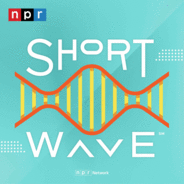Ever eat a full meal ... and find you still have room for dessert? If so, you're not alone. Sugar is a quick form of energy that many people crave — even when they're full. Today, hosts Emily Kwong and Regina G. Barber dive into a new study on the neural origins of the "dessert brain."Want us to cover more neuroscience on the show? Let your voice be counted by emailing shortwave@npr.org! Listen to every episode of Short Wave sponsor-free and support our work at NPR by signing up for Short Wave+ at plus.npr.org/shortwave.Learn more about sponsor message choices: podcastchoices.com/adchoicesNPR Privacy Policy

Wissenschaft & Technik
Short Wave Folgen
New discoveries, everyday mysteries, and the science behind the headlines — in just under 15 minutes. It's science for everyone, using a lot of creativity and a little humor. Join hosts Emily Kwong and Regina Barber for science on a different wavelength.If you're hooked, try Short Wave Plus. Your subscription supports the show and unlocks a sponsor-free feed. Learn more at plus.npr.org/shortwave
Folgen von Short Wave
1400 Folgen
-
Folge vom 21.02.2025This Is Your Brain On Dessert
-
Folge vom 19.02.2025Party In Peru: New Critters Just DroppedWhat happens when a team of scientists and local Awajún guides go on a 38-day trip into the Alto Mayo region of Peru? Over 2000 species are identified, of course! Tucked in this lush landscape where the Amazon basin meets the Andes mountains, were 27 species of animals previously unknown to science. It makes us wonder, what else is out there that the scientific community hasn't seen? And who already knows about it? Check out photos of all the critters we mentioned — and more!Other ecosystems or critters you think would make a good episode? Let us know by emailing shortwave@npr.org!Listen to every episode of Short Wave sponsor-free and support our work at NPR by signing up for Short Wave+ at plus.npr.org/shortwave.Learn more about sponsor message choices: podcastchoices.com/adchoicesNPR Privacy Policy
-
Folge vom 18.02.2025When AI Cannibalizes Its DataAsked ChatGPT anything lately? Talked with a customer service chatbot? Read the results of Google's "AI Overviews" summary feature? If you've used the Internet lately, chances are, you've consumed content created by a large language model. These models, like DeepSeek-R1 or OpenAI's ChatGPT, are kind of like the predictive text feature in your phone on steroids. In order for them to "learn" how to write, the models are trained on millions of examples of human-written text. Thanks in part to these same large language models, a lot of content on the Internet today is written by generative AI. That means that AI models trained nowadays may be consuming their own synthetic content ... and suffering the consequences.View the AI-generated images mentioned in this episode.Have another topic in artificial intelligence you want us to cover? Let us know my emailing shortwave@npr.org!Listen to every episode of Short Wave sponsor-free and support our work at NPR by signing up for Short Wave+ at plus.npr.org/shortwave.Learn more about sponsor message choices: podcastchoices.com/adchoicesNPR Privacy Policy
-
Folge vom 17.02.2025Could This Particle 'Clean Up' A Cosmic Mystery?Physics has a bit of a messy problem: There's matter missing in our universe. Something is there that we can't see but can detect! What could this mysterious substance be? A lot of astronomers are searching for the answer. And some, like theoretical particle physicist Chanda Prescod-Weinstein, think a hypothetical particle called the axion may make this problem a little ... tidier. That's right: hypothetical. Scientists have never seen one, and don't know if they exist. So today, we point our cosmic magnifying glasses towards the axion and ask how scientists could find one — and if it could be the neat solution physicists have been searching for. Help shape the future of Short Wave by taking our survey: npr.org/shortwavesurveyListen to every episode of Short Wave sponsor-free and support our work at NPR by signing up for Short Wave+ at plus.npr.org/shortwave.Learn more about sponsor message choices: podcastchoices.com/adchoicesNPR Privacy Policy
